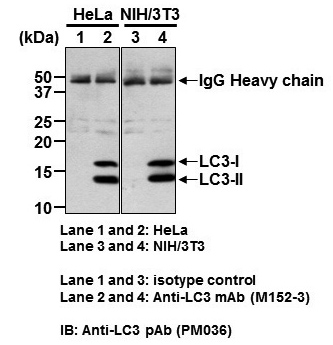This site is for customers in Asia.
Customers in China & other regions, please go to Global page.
HOME >
Product search results > Code No. M152-3MS
Anti-LC3 mAb for My select sampler set
Availability (in Japan)
1-9
(In Japan at 00:05,
Apr 24, 2024 in JST)
Size
20 µL (2 mg/mL)
| Data | |||||
|---|---|---|---|---|---|
| Clonality | Monoclonal | Clone | 4E12 | ||
| Isotype (Immunized Animal) | Mouse IgG1 κ | ||||
| Applications | |||||
| Immunogen (Antigen) | Recombinant Human LC3 (MAP1LC3B: 1-120 a.a.) | ||||
| Reactivity [Gene ID] | Human[81631/84557], Mouse[67443/66734], Rat[64862/362245], Hamster[100760576/100769810] |
||||
| Storage buffer | 2 mg/mL in PBS/50% glycerol, pH 7.2 | ||||
| Storage temp. | -20°C | Conjugate | Unlabeled | Manufacturer | MBL |
| Alternative names | microtubule-associated protein 1 light chain 3 beta, microtubule-associated protein 1 light chain 3 alpha, LC3B, ATG8F, MAP1LC3B-a, MAP1A/1BLC3, MAP1LC3B, LC3A, ATG8E, MAP1ALC3, MAP1BLC3, MAP1LC3A | ||||
| Background | Macroautophagy mediates the bulk degradation of cytoplasmic components. These components are delivered to lysosomes via autophagosomes. The rat microtubule-associated protein 1 light chain 3 (LC3), a homologue of yeast Atg8 (Aut7/Apg8), localizes to autophagosomal membranes after post-translational modifications. The C-terminal fragment of LC3 is cleaved immediately following synthesis to yield a cytosolic form called LC3-I. A subpopulation of LC3-I is further converted to an autophagosome-associating form, LC3-II. This antibody can detect both forms of LC3. | ||||
| Related products | M135-3 Anti-GABARAP mAb PM038 Anti-GATE-16 pAb PM039 Anti-Atg7 (Human) pAb 8485 Autophagy Ab Sampler Set PM036-PN Positive control for anti-LC3 antibody M133-3 Anti-Atg3 mAb PM036 Anti-LC3 pAb M186-3 Anti-LC3 mAb PD014 Anti-LC3 pAb PM072 Anti-VMP1 pAb PM045 Anti-p62 (SQSTM1) pAb M162-3 Anti-p62 (SQSTM1) (Human) mAb PM066 Anti-p62 C-terminal pAb PD017 Anti-Beclin 1 pAb PM037 Anti-GABARAP pAb 8486 Autophagy Watch |
||||
| Citations |
Western Blotting
Immunoprecipitation
Immunocytochemistry
Immunohistochemistry
Other(Immuno-EM)
|
||||
| Product category |
|
||||
- The availability is based on the information in Japan at 00:05, Apr 24, 2024 in JST.
- The special price is shown in red color.
- Please note that products cannot be ordered from this website. To purchase the items listed in this website, please contact us or local distributers.
- Abbreviations for applications:
WB: Western Blotting, IH: Immunohistochemistry, IC: Immunocytochemistry, IP: Immunoprecipitation
FCM: Flow Cytometry, NT: Neutralization, IF: Immunofluorescence, RIP: RNP Immunoprecipitation
ChIP: Chromatin Immunoprecipitation, CoIP: Co-Immunoprecipitation - For applications and reactivity:
*: The use is reported in a research article (Not tested by MBL). Please check the data sheet for detailed information.
**: The use is reported from the licenser (Under evaluation or not tested by MBL).
- For storage temparature: RT: room temparature
- Please note that products in this website might be changed or discontinued without notification in advance for quality improvement.














 Citations
Citations Data Sheet
Data Sheet



